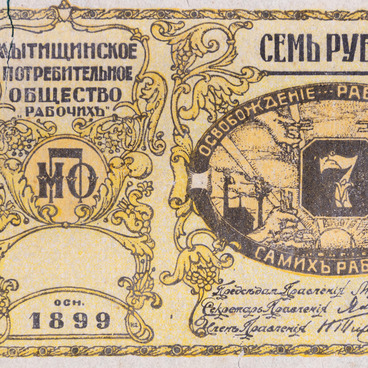After the death of Vasily Chelnokov, the founder of the brick factory next to the Sharapovo village near Bolshie Mytishchi, his five children inherited the factory. In 1887, an agreement was signed between the four sons and the daughter Elena, according to which the brothers Sergei, Mikhail, Vasily, and Fyodor got 50 desyatinas (approx. 0.21 sq. miles) of land. At the time, the Mytishchi factory produced six million bricks a year with a total cost of 120,000 rubles. The factory employed 310 workers.
On January 1, 1887, a trading house was established as a full partnership ‘V. K. Shaposhnikov and M. V. Chelnokov’. The Partneship for manufacture and sale of construction materials ‘V. K. Shaposhnikov, M. V. Chelnokov and C°’ incorporated all the Moscow trading houses of Chelnokov’s inheritors. Since then, all brick were branded with the mark “Imperially Established Partnership Shaposhnikov, Chelnokov, and C°”.
Inheritors were still engaged in brick manufacture and sales. They upgraded their equipment which helped them increase overall output with less hired staff. By 1894, the factory produced 8 million bricks a year with a total cost of 160,000 rubles with only 204 workers. The Chelnokov also purchased land, and in the end in 1905 they had “209 desyatinas (0.88 sq. miles) in property and rented 41 desyatinas (0.172 sq. miles) from peasants)”.
The range of construction materials produced by the Partnership was huge. According to the 1905 “List of Joint-Stock Companies and Trading Houses Operating in the Empire, ” “Since the day of its establishment, the Partnership For Manufacture and Sales of Construction Materials 'V. K. Shaposhnikov, M. V. Chelnokov and Co' took measures to grow which resulted in an increased output, purchase of new lands, purchase of new production machinery… The Partnership produced bricks, lime, Roman cement, rubble, and peat at their own factories located in the Moscow Governorate. The goods produced at the factories are sold mostly in the Moscow and adjacent Governorates: Smolensk, Yaroslavl, Nizhny Novgorod, Vladimir, and Kostroma Governorates.” Many buildings in Moscow and other cities of Russia were made form bricks produced at the Mytishchi factory.
On January 1, 1887, a trading house was established as a full partnership ‘V. K. Shaposhnikov and M. V. Chelnokov’. The Partneship for manufacture and sale of construction materials ‘V. K. Shaposhnikov, M. V. Chelnokov and C°’ incorporated all the Moscow trading houses of Chelnokov’s inheritors. Since then, all brick were branded with the mark “Imperially Established Partnership Shaposhnikov, Chelnokov, and C°”.
Inheritors were still engaged in brick manufacture and sales. They upgraded their equipment which helped them increase overall output with less hired staff. By 1894, the factory produced 8 million bricks a year with a total cost of 160,000 rubles with only 204 workers. The Chelnokov also purchased land, and in the end in 1905 they had “209 desyatinas (0.88 sq. miles) in property and rented 41 desyatinas (0.172 sq. miles) from peasants)”.
The range of construction materials produced by the Partnership was huge. According to the 1905 “List of Joint-Stock Companies and Trading Houses Operating in the Empire, ” “Since the day of its establishment, the Partnership For Manufacture and Sales of Construction Materials 'V. K. Shaposhnikov, M. V. Chelnokov and Co' took measures to grow which resulted in an increased output, purchase of new lands, purchase of new production machinery… The Partnership produced bricks, lime, Roman cement, rubble, and peat at their own factories located in the Moscow Governorate. The goods produced at the factories are sold mostly in the Moscow and adjacent Governorates: Smolensk, Yaroslavl, Nizhny Novgorod, Vladimir, and Kostroma Governorates.” Many buildings in Moscow and other cities of Russia were made form bricks produced at the Mytishchi factory.



